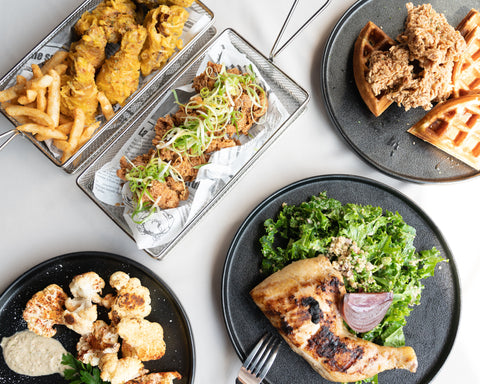Let’s face it. All parents are guilty of giving their kids a sugary snack or feeding them foods that probably aren’t the best for their growing bodies. But in the fast pace world we live in, a healthy, home cooked meal is slowly becoming a thing of the past. Many parents simply don’t have the time to plan and prepare a delicious and nutritious breakfast, lunch, or dinner for their family.
So, what happens? Many parents have to sacrifice healthy, nutritious meals for convenient ones instead. Kids get used to, and ultimately crave, junk food like hot dogs, hamburgers, and fried foods. They become addicted to drinking incredibly sugary drinks like soda, juice, and sports drinks. Unfortunately, this leads to the serious problem of overweight children, some of whom develop childhood diabetes.
According to the CDC, childhood obesity in the United States affects 13.7 million children and adolescents between the ages of 2 and 19. And with schools questioning the importance of physical education versus regular academics, the problem is likely going to get worse.
But how do you as a parent go about finding a solution? The best place to start is to look at the worst foods most commonly given to children and then make suggestions for healthier alternatives.
The Bad List
-
Soda - Probably one of the biggest contributors to obesity and diabetes is soda, or pop depending on where you live (or just “Coke” for you strange people.) As a person who used to have a soda addiction, I know first hand this is one of the worst drinks to give your children. And if you think diet sodas are any better, think again. The debate about the safety of artificial sweeteners in soft drinks is still a hot button issue.
-
Fruit Juice - While not as big an offender as soda, which has absolutely no nutritional value whatsoever, fruit juice is loaded with excess sugars, even those that are made with 100% juice. Besides the added sugars, much of the nutritional value of a fruit is lost when people only consume the juice.
For many families on a budget, the "juice" consumed most frequently isn’t even real juice. Budget juice drinks often contain 10% or less of actual juice, the rest being artificial flavors. Essentially, your kids are drinking fruit punch.
-
Fruit Snacks - Sorry parents, but fruit snacks like gummies or rolls are really just fruit juice in a different form. Though that package might say they’re flavored with real fruit flavors, the majority of those tiny gummies are just sugar. You’re better off sticking with actual fruit.
-
Microwaveable Finger Foods - Add this to the list of convenient foods that save time for mom and dad. Many of the microwaveable meals you serve to your children are flash fried and then frozen, like chicken tenders and nuggets. This is essentially the same way food is prepared for fast food chains. Many meals like these contain massive amounts of salt and saturated fat, which is a horrible combination for anyone but especially for a young person who doesn’t exercise enough. Frozen burgers, corn dogs, and breakfast sandwiches are all guilty of being poor choices for meals.
-
Chips - Salt, when over consumed, can be just as bad for the body as sugar. Potato chips, corn chips, and puffed cheese snacks are loaded with salt and flavorings. While even I love a bag of Flamin’ Hot Cheetos, they’re definitely not good for anyone to consume on a regular basis.
Most chips are cooked by deep frying, and deep fried foods aren’t great for young hearts and bodies. Baked chips, though they avoid much of the added fats added by frying in oil, still have salty flavorings which make them addictive. Some flavors, especially BBQ, contain sugars which give them a slightly sweet taste.
The Good List
-
Apples - The old saying, “an apple a day keeps the doctor away” is still true to this day. Giving apple slices to your kids as a snack is one of the most nutritious options since they're full of fiber, water, and natural sugars. They're also low in calories, full of vitamins, and available in sweet and tart varieties. Apples make great after school and lunch snacks.
While great on their own, avoid getting carried away pairing apple slices with condiments like caramel and chocolate hazelnut spread. These contain extra sugars that can quickly turn a healthy snack into an unhealthy one.
-
Yogurt - Have a kid who doesn’t like milk? Yogurt is another option that’s full of calcium and, when mixed with fruits and berries, can make a delicious breakfast. To get the best benefits from yogurt, avoid the flavored types which are likely loaded with excess sugars to make the yogurt taste a bit better. Instead, find yogurt that’s low fat and has fewer than 8 grams of sugar. Additionally, check if the yogurt contains active cultures to provide their tummies with beneficial bacteria.
-
Breakfast Cereal - No, your fruity flavored rings are NOT a healthy breakfast. If your cereal has frosting or has added sugars, it should definitely be avoided. Giving your kids sugars first thing in the morning could lead to a sugar crash in the middle of school when they need to be at their best.
Instead, look for whole-grain cereals and selections that have added fiber, such as shredded wheat. To add some flavor, include berries, banana slices, or even a few raisins to cereal to give that little bit of natural sugar they're craving.
-
Vegetables - Well, this one was probably a no-brainer. Everyone, young and old, should eat veggies on a daily basis. The problem is most kids wouldn’t willingly touch a vegetable without a fight. The trick is to introduce kids to vegetables early and start with the ones that generally everyone likes such as corn, carrots, and potatoes.
Gradually start introducing more leafy green veggies like broccoli, spinach, celery, and others. Make sure you’re not giving your kids veggies you’re not willing to eat yourself. Teach by example. If you don’t like brussel sprouts, don’t force your kids to eat them just because they’re healthy. There are plenty of other vegetables to choose from that everyone will like.
-
Fruits - When you've become accustomed to sugary drinks and snacks, keeping sugar cravings under control can be incredibly difficult. Strawberries, grapes, watermelon, and so many other fruits contain beneficial vitamins, minerals, and especially fiber that young bodies need and that hint of sweetness to calm a sweet tooth.
Avoid anything that sweetens fruit with anything other than their natural juices. Fruits can come fresh, frozen, canned, or even dried. Use frozen fruit in smoothies, fresh fruit in breakfast cereal, and dried fruit in snacks like trail mix.
Of course, it’s always a good idea to talk with a pediatrician to get the best advice on what types of foods your child should be eating, especially if your child has a specific food allergy.
When possible, do your best to make time an prepare healthy meals. Avoid eating out too often or relying on pre-packaged, frozen food. It’s important kids learn to appreciate healthy, natural foods when they’re young so they aren’t resistant to eating them when they’re older. Teaching them to make healthy choices versus eating sugary or salty snacks can help them to avoid costly and potentially deadly health issues when they get older.




Comments (0)
There are no comments for this article. Be the first one to leave a message!